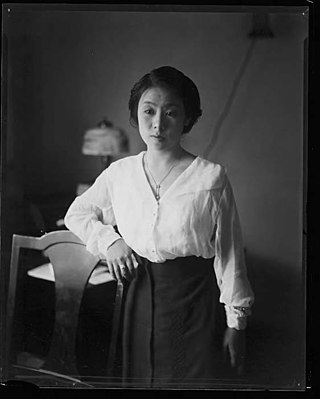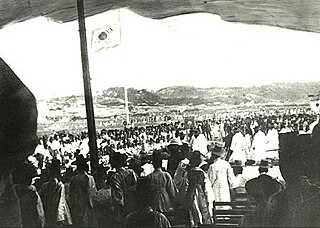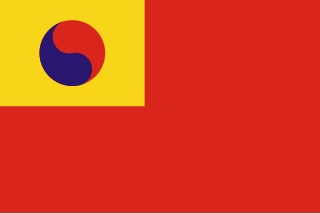
Korean Americans are Americans who are of full or partial Korean ethnic descent. The majority of Korean Americans trace their ancestry to South Korea.

Seo Jae-pil, better known by his English name Philip Jaisohn, was a Korean American politician, physician, and Korean independence activist. He was the first Korean to become a naturalized citizen of the United States. He also founded the Tongnip Sinmun, the first Korean newspaper written entirely in Hangul.

A Koreatown (Korean: 코리아타운), also known as a Little Korea or Little Seoul, is a Korean-dominated ethnic enclave within a city or metropolitan area outside the Korean Peninsula.
The Chinese in Hawaii constitute about 4.7% of the state's population, most of whom (75%) are Cantonese people with ancestors from Zhongshan in Guangdong. This number does not include people of mixed Chinese and Hawaiian descent. If all people with Chinese ancestry in Hawaii are included, they form about 1/3 of Hawaii's entire population. As United States citizens, they are a group of Chinese Americans. A minority of this group have Hakka ancestry.

Ahn Chang Ho, sometimes An Chang-ho, was a prominent Korean politician, Korean independence activist, and an early leader of the Korean-American immigrant community in the United States. He is also commonly referred to by his art name Dosan.

The Japanese in Hawaii are the second largest ethnic group in Hawaii. At their height in 1920, they constituted 43% of Hawaii's population. They now number about 16.7% of the islands' population, according to the 2000 U.S. Census. The U.S. Census categorizes mixed-race individuals separately, so the proportion of people with some Japanese ancestry is likely much larger.
The term picture bride refers to the practice in the early 20th century of immigrant workers in Hawaii and the West Coast of the United States and Canada, as well as Brazil selecting brides from their native countries via a matchmaker, who paired bride and groom using only photographs and family recommendations of the possible candidates. This is an abbreviated form of the traditional matchmaking process and is similar in a number of ways to the concept of the mail-order bride.

Puerto Rican migration to Hawaii began when Puerto Rico's sugar industry was devastated by two hurricanes in 1899. The devastation caused a worldwide shortage in sugar and a huge demand for the product from Hawaii. Consequently, Hawaiian sugarcane plantation owners began to recruit the jobless, but experienced, laborers from Puerto Rico. In thirteen separate groups, 5883 Puerto Rican men, women and children traveled by ship, train then ship again to the islands of Hawaii to begin their new lives in the sugar plantations.
Asian immigration to the United States refers to immigration to the United States from part of the continent of Asia, which includes East Asia, South Asia, and Southeast Asia. Asian-origin populations have historically been in the territory that would eventually become the United States since the 16th century. The first major wave of Asian immigration occurred in the late 19th century, primarily in Hawaii and the West Coast. Asian Americans experienced exclusion, and limitations to immigration, by the United States law between 1875 and 1965, and were largely prohibited from naturalization until the 1940s. Since the elimination of Asian exclusion laws and the reform of the immigration system in the Immigration and Nationality Act of 1965, there has been a large increase in the number of immigrants to the United States from Asia.

Sugarcane was introduced to Hawaiʻi by its first inhabitants in approximately 600 AD and was observed by Captain Cook upon arrival in the islands in 1778. Sugar quickly turned into a big business and generated rapid population growth in the islands with 337,000 people immigrating over the span of a century. The sugar grown and processed in Hawaiʻi was shipped primarily to the United States and, in smaller quantities, globally. Sugarcane and pineapple plantations were the largest employers in Hawaiʻi. Today the sugarcane plantations are gone, production having moved to other countries.

Asian American history is the history of ethnic and racial groups in the United States who are of Asian descent. The term "Asian American" was an idea invented in the 1960s to bring together Chinese, Japanese, and Filipino Americans for strategic political purposes. Soon other groups of Asian origin, such as Korean, Indian, and Vietnamese Americans were added. For example, while many Chinese, Japanese, and Filipino immigrants arrived as unskilled workers in significant numbers from 1850 to 1905 and largely settled in Hawaii and California, many Vietnamese, Cambodian, and Hmong Americans arrived in the United States as refugees following the Vietnam War. These separate histories have often been overlooked in conventional frameworks of Asian American history.

The People's Joint Association was a mass organization started in 1897 of Korean independence activists in the Korean Empire. It was done as part of Independence Club.
The following is a timeline of the Gwangmu Reform, which was a reforms for modernize Korea from the late 19th century to the early 20th century.
Most early Asian settlers to the United States went to Hawaii. Most of these early immigrants moved to the islands as laborers to work on the pineapple, coconut, and sugarcane plantations. These early migrants have tended to stay, although a handful returned to their home countries. There has also been recent immigration to Hawaii from more ethnic Asian groups, including Thai, Indian, Indonesian, and Vietnamese.

Spanish immigration to Hawaii began in 1907 when the Hawaiian government and the Hawaiian Sugar Planters' Association (HSPA) decided to supplement their ongoing importation of Portuguese workers to Hawaii with workers recruited from Spain. Importation of Spanish laborers, along with their families, continued until 1913, at which time more than 9,000 Spanish immigrants had been brought in, most recruited to work primarily on the Hawaiian sugarcane plantations.

Spreckelsville is an unincorporated community on the northeastern coast of the west side of the island of Maui in the U.S. state of Hawaii.
Ha Soo Whang, was a Korean American social worker. She was the first Korean social worker in Hawaii, and acted as a bilingual interpreter for the families under her care. A graduate of Athens College, she was affiliated with the YWCA's International Institute. She is credited with spreading the art of Korean dance in Hawaii.

The Korean National Revolutionary Party, or KNRP, was a nationalist party formed by exiles in Shanghai in 1935 to resist the Japanese occupation of Korea. At first it was the main nationalist Korean political party, but as the Sino-Japanese War (1937–45) progressed the rival Korean National Party, later Korea Independence Party, gained more influence with the Chinese Nationalist government in Chongqing and came to dominate the Korean Provisional Government. The KNRP of America was a significant factor as a source of funds and a link to the US government. The KNRP was dissolved in 1947.

The Korean National Association, also known as All Korea Korean National Association, was a political organization established on February 1, 1909, to fight Japan's colonial policies and occupation in Korea. It was founded in San Francisco by the intellectual scholar and Korean Independence activist Ahn Changho, and represented the interests of Koreans in the United States, Russian Far East, and Manchuria during the Korean Independence Movement.

Pachappa Camp was founded in 1904 and is one of the earliest significant Korean settlements established in the United States. It was founded by Ahn Changho, one of the earliest Korean immigrants to the United States and a prominent Korean independence activist. Located in downtown Riverside, California, the original address of the site was 1532 Pachappa Avenue but has since been changed to 3096 Cottage Street. The settlement was active until 1918 and at peak season hosted nearly 300 people. Pachappa Camp is labeled the first Korean settlement in the United States by several historians and the Riverside City government, but this label is disputed by historian John Cha. On March 23, 2017, the Riverside City Council designated the Pachappa Camp site as a “Point of Cultural Interest.”
















